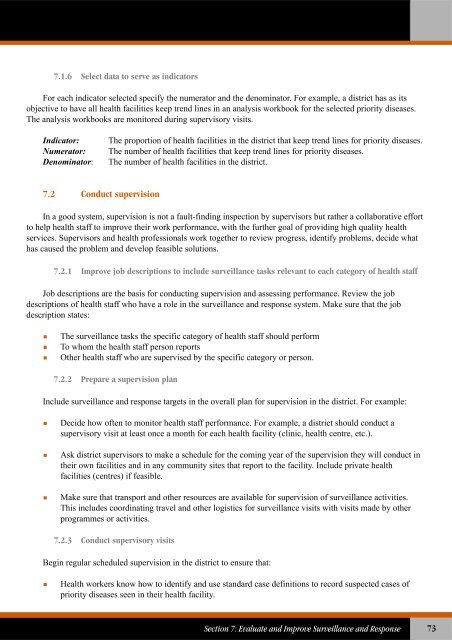Technical Guidelines for Integrated Disease Surveillance ... - PHRplus
Technical Guidelines for Integrated Disease Surveillance ... - PHRplus
Technical Guidelines for Integrated Disease Surveillance ... - PHRplus
Create successful ePaper yourself
Turn your PDF publications into a flip-book with our unique Google optimized e-Paper software.
7.1.6 Select data to serve as indicatorsFor each indicator selected specify the numerator and the denominator. For example, a district has as itsobjective to have all health facilities keep trend lines in an analysis workbook <strong>for</strong> the selected priority diseases.The analysis workbooks are monitored during supervisory visits.Indicator:Numerator:Denominator:The proportion of health facilities in the district that keep trend lines <strong>for</strong> priority diseases.The number of health facilities that keep trend lines <strong>for</strong> priority diseases.The number of health facilities in the district.7.2 Conduct supervisionIn a good system, supervision is not a fault-finding inspection by supervisors but rather a collaborative ef<strong>for</strong>tto help health staff to improve their work per<strong>for</strong>mance, with the further goal of providing high quality healthservices. Supervisors and health professionals work together to review progress, identify problems, decide whathas caused the problem and develop feasible solutions.7.2.1 Improve job descriptions to include surveillance tasks relevant to each category of health staffJob descriptions are the basis <strong>for</strong> conducting supervision and assessing per<strong>for</strong>mance. Review the jobdescriptions of health staff who have a role in the surveillance and response system. Make sure that the jobdescription states:The surveillance tasks the specific category of health staff should per<strong>for</strong>mTo whom the health staff person reportsOther health staff who are supervised by the specific category or person.7.2.2 Prepare a supervision planInclude surveillance and response targets in the overall plan <strong>for</strong> supervision in the district. For example:Decide how often to monitor health staff per<strong>for</strong>mance. For example, a district should conduct asupervisory visit at least once a month <strong>for</strong> each health facility (clinic, health centre, etc.).Ask district supervisors to make a schedule <strong>for</strong> the coming year of the supervision they will conduct intheir own facilities and in any community sites that report to the facility. Include private healthfacilities (centres) if feasible.Make sure that transport and other resources are available <strong>for</strong> supervision of surveillance activities.This includes coordinating travel and other logistics <strong>for</strong> surveillance visits with visits made by otherprogrammes or activities.7.2.3 Conduct supervisory visitsBegin regular scheduled supervision in the district to ensure that:Health workers know how to identify and use standard case definitions to record suspected cases ofpriority diseases seen in their health facility.Section 7: Evaluate and Improve <strong>Surveillance</strong> and Response73















